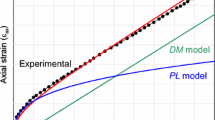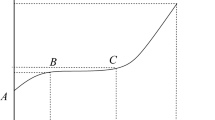Abstract
The double-mechanism creep law (DM model) is an empirical creep constitutive model widely employed in Brazilian salt rock mechanics. This model often presents good performance in steady-state creep prediction. However, transient creep is not accounted for, and whenever early creep estimates are important, the contribution of this phase might be meaningful. This work adds value by presenting two alternatives to account for transient creep in the DM model. The first alternative couples the transient function from Sandia’s multi-mechanism deformation model to the DM model steady-state creep rate (EDMT model). The second alternative couples the DM model response to Norton’s power law when the strain rate given by the latter remains lower than the one from the former (EDMP model). These models can be implemented in numerical simulators at small code extensions of the DM model implementations. Applications from previous works by the authors are revisited to validate the formulations based on experimental data. EDMT and EDMP models differ in the formulation of transient creep and, consequently, in the time of transition between the transient and the steady-state phases. Both methods were successful in treating transient creep and in simulating experimental results.

Experimental data from Costa et al. [8] adapted by the authors



Field data from D’Ellia [9]


Field data from Medeiros [17] adapted by the authors





Similar content being viewed by others
References
Alejano LR, Alonso E (2005) Considerations of the dilatancy angle in rocks and rock masses. Int J Rock Mech Min 42:481–507
Brandao NB (2016) Modelling of the evolution of the mechanical properties of cement paste in Pre-salt wells. MSc. Dissertation, Department of Civil Engineering—Pontifical Catholic University of Rio de Janeiro (PUC-Rio) (in Portuguese)
Brandao NB, Roehl D (2016) Modelling cement hardening in Pre-salt wells. In: Proceedings, 50th US rock mechanics/geomechanics symposium (ARMA symposium), held 26–29 June, Houston, United States of America
Costa AM (1984) An application of computational methods and rock mechanics principles to the design and analysis of underground mine excavations. D.Sc. Thesis, COPPE—Federal University of Rio de Janeiro (UFRJ) (in Portuguese)
Costa AM, Amaral CS, Poiate E Jr, Pereira AMB, Martha LF, Gattass M, Roehl D (2012) Underground storage of natural gas and CO2 in salt caverns in deep and ultra-deep water offshore Brazil. In: Zhou Qian (ed) Harmonising rock engineering and the environment (12th ISRM congress), held October 16–21. Beijing, China, pp 1659–1664
Costa AM, Medeiros FAS, Fonseca CFH, Amaral CS, Gonçalves CJC (2000) Drilling through long salt intervals in Campos basin—Brazil. In: Proceedings, eighth salt symposium, held 07–11 May, The Hague, Netherlands, pp 247–252
Costa AM, Poiate Jr E, Amaral CS, Gonçalves CJC, Falcão JL, Pereira A (2010) Geomechanics applied to the well design through salt layers in Brazil: a history of success. In: Proceedings, 44th US rock mechanics symposium and 5th US-Canada rock mechanics symposium (ARMA symposium), held 27–30 June, Utah, United States of America
Costa AM, Poiate Jr E, Falcão JL, Coelho LFM (2005) Triaxial creep tests in salt applied in drilling through thick salt layers in campos basin. In: Proceedings, IADC/SPE drilling conference, held 23–25 February, Amsterdam, The Netherlands
D’Ellia PC (1991) Analysis and back-analysis of the creep behavior in underground excavations by the finite element method. MSc. dissertation, COPPE—Federal University of Rio de Janeiro (UFRJ) (in Portuguese)
Dusseault MB (1989) Saltrock behavior as an analogue to the behavior of rock at great depth. In: Maury V, Fourmaintraux D (eds) Rock at great depth (ISRM international symposium), held August 30th–September 2nd, Pau, France, pp 11–17
Dusseault MB, Rothenburg L, Mraz DZ (1987) The design of openings in salt rock using a multiple mechanism viscoplastic law. In: Proceedings, 28th US symposium on rock mechanics, held June 29th–July 1st, Tucson, United States of America, pp 633–642
Firme PALP (2013) Constitutive modeling and probabilistic analysis applied to wells in salt zones. MSc. dissertation, Department of Civil Engineering—Pontifical Catholic University of Rio de Janeiro (PUC-Rio) (in Portuguese)
Firme PALP, Roehl D, Romanel C (2016) An assessment of the creep behaviour of Brazilian salt rocks using the multi-mechanism deformation model. Acta Geotech 11:1445–1463
Firme PALP, Roehl D, Romanel C, Poiate E Jr, Costa AM (2015) Multi-mechanism deformation creep model applied to Brazilian salt rocks. In: Roberts, Mellergard, Hansen (eds) The mechanical behaviour of salt VIII conference (Salt Mech 8), held 26–28 May, Rapid City, United States of America. Taylor & Francis Group/CRC Press/Balkema, London, pp 339–349
Lomenick TF, Bradshaw RL (1969) Deformation of rock salt in openings mined for the disposal of radioactive wastes. Rock Mech 1(1):5–30
Lux K-H, Heusermann S (1983) Creep tests on rock salt with changing load as a basis for the verification of theoretical material laws. In: Proceedings, sixth international symposium on salt, held May, Toronto, Canada, pp 417–435
Medeiros FAS (1999) Análise do comportamento de colunas de revestimento frente à movimentação do sal em poços de petróleo. MSc. dissertation, Department of Civil Engineering—Pontifical Catholic University of Rio de Janeiro (PUC-Rio) (in Portuguese)
Mraz D, Rothenburg L, Dusseault MB (1991) Design of mines in salt and potash. In: Proceedings, 7th ISRM congress, held 16–20 September, Aachen, Germany, pp 1837–1845
Munson DE (2004) M-D constitutive model parameters defined for gulf coast salt domes and structures. In: Proceedings, gulf rocks 2004, the 6th North America rock mechanics symposium (NARMS): rock mechanics across borders and disciplines (ARMA symposium), held 05–09 June, Houston, United States of America
Munson DE, Dawson PR (1979) Constitutive model for the low temperature creep of salt (with application to WIPP), SAND79-1853. Sandia National Laboratories, Albuquerque
Poiate Jr E (2012) Rock mechanics and computational mechanics for the design of oil wells in salt zones. DSc. thesis, Department of Civil Engineering—Pontifical Catholic University of Rio de Janeiro (PUC-Rio) (in Portuguese)
Poiate Jr E, Costa AM, Falcão JL (2006) Well design for drilling through thick evaporite layers in Santos basin, Brazil. In: Proceedings, IADC/SPE drilling conference, held 21–23 February, Miami, United States of America
Urai JL, Schléder Z, Spiers CJ, Kukla PA (2008) Flow and transport properties of salt rocks. In: Littke et al (eds) Dynamics of complex intracontinental basins: the central European basin system. Springer, Berlin-Heidelberg, pp 277–290
Urai JL, Spiers CJ, Hendrik JZ, Lister GS (1986) Weakening of rock salt by water during long-term creep. Nature 324:554–557
Urai JL, Spiers CJ (2007) The effect of grain boundary water on deformation mechanisms and rheology of rocksalt during long-term deformation. In: Wallner et al (eds) Proceedings of the 6th conference on the mechanical behavior of salt: understanding of THMC processes in salt rocks (Salt Mech 6), held 22–25 May, Hannover, Germany. Taylor & Francis Group, London, pp 149–158
van Sambeek L, Fossum A, Callahan G, Ratigan J (1993) Salt mechanics: empirical and theoretical developments. In: Proceedings, seventh symposium on salt, held 06–09 April, Kioto, Japan, pp 127–134
van Sambeek LL, Ratigan JL, Hansen FD (1993) Dilatancy of rock salt in laboratory tests. Int J Rock Mech Min Sci Geomech Abstr 30(7):735–738
Zhu C, Arson C (2014) A thermo-mechanical damage model for rock stiffness during anisotropic crack opening and closure. Acta Geotech 9:847–867
Author information
Authors and Affiliations
Corresponding author
Additional information
Publisher's Note
Springer Nature remains neutral with regard to jurisdictional claims in published maps and institutional affiliations.
Rights and permissions
About this article
Cite this article
Firme, P.A.L.P., Brandao, N.B., Roehl, D. et al. Enhanced double-mechanism creep laws for salt rocks. Acta Geotech. 13, 1329–1340 (2018). https://doi.org/10.1007/s11440-018-0689-7
Received:
Accepted:
Published:
Issue Date:
DOI: https://doi.org/10.1007/s11440-018-0689-7







